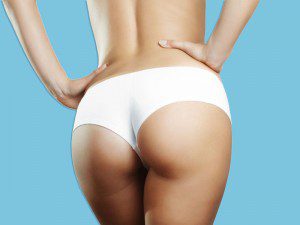Butt Augmentation
-
Content written by Andrew Proulx, MD | Reviewed by EnhanceMyself Medical Team | Last updated 6/27/2023
- Overview
Overview
What is butt augmentation?
Time can be unkind to the body, especially the buttocks – the only body part we sit on. Furthermore, many people just don’t have the round shapely butt they want because of genetics, fluctuations in weight, pregnancy, or poor tissue elasticity. Either way, those who wish to sport rounder, fuller buttocks may want to consider butt augmentation. Butt augmentation is a cosmetic surgical procedure aimed at enhancing the size and shape of the buttocks.
Types of buttock augmentations
Gluteal augmentation, also known as “buttock augmentation” may be done in several ways:
- Gluteal fat grafting (Brazilian Butt Lifts): Fat is removed from one part of the body and implanted into the buttocks (see fat injections).
- Gluteoplasty (buttocks lift): Excess skin and fat are removed from the buttocks, and the remaining tissue is adjusted and contoured.
- Filler injections: Fillers such as Sculptra, are injected into the buttocks area to provide temporary fullness.
- Buttocks implants: Silicone prostheses are surgically placed into the buttocks.
Cost of butt augmentation
The average cost of butt augmentation with fat grafting is $4,807, the average cost of butt implants is $5,278 and the average cost of a butt lift is $5,482 according to the American Society of Plastic Surgeons (ASPS), however this only includes the surgeon’s fee. There are several other factors that can affect the cost of your procedure. Here are some of the top factors that influence cost.
- Your Surgeon: The experience and reputation of the surgeon performing your procedure can affect the cost. Highly skilled and well-known cosmetic surgeons often charge a premium for their services.
- Anesthesia: The type of anesthesia used, the duration of the butt augmentation procedure, and the qualifications of the anesthesiologist can influence the anesthesia fees.
- Type of Procedure: The extent of your butt augmentation procedure (implants, fat transfer, Sculptra) will impact cost.
- Surgical Facility: The surgical facility where your butt augmentation is being performed may impact the cost. These fees cover the usage of the operating room and other associated services.
- Location Matters: The cost of living and the average pricing for medical services in a particular area can affect the cost of your procedure. In general, urban areas tend to have higher procedure fees.
- Pre and Postoperative Care: This includes consultations, medical tests, surgical garments, medications, and follow-up appointments.
- Additional Procedures: Your cost may be higher if you’re considering having other procedures along with your butt augmentation.
When taking these additional factors into consideration, the total cost of butt augmentation surgery is between $3,000 to $14,000.
If you are considering butt augmentation surgery, setup a consultation with a board-certified plastic surgeon near you. This will allow you to discuss your aesthetic goals and gain a better understanding of all the potential costs involved.
Total cost of butt augmentation types
The following provides an overview of the total average cost for different types of butt augmentations:
- Butt Implants: $7,000 to $10,000 or more.
- Fat Transfer (Brazilian Butt Lift): $8,000 to $14,000.
- Buttock Injections (Non-surgical): $3,000 to $6,000 or more.
Are you a candidate?

Are you a good candidate for butt augmentation?
The ideal candidate for buttocks augmentation using an implant is of healthy weight (BMI 30 or less), in good general health, and has enough soft tissue (skin and underlying fat and muscle) to accommodate an implant. Surgeons look for the following concerns with the buttocks that can be corrected or improved by this surgery:
- Lack of volume
- Lack of projection
- Asymmetry between the buttocks
- Contour irregularities or deformities
- Limited fat for transfer
The following problems are concerns that may make individuals poor candidates for buttocks augmentation:
- BMI greater than 30
- Prior buttocks injections
- Autoimmune disease (such as lupus or vasculitis)
- Prior history of radiation treatments to the buttocks area
The following are contraindications to this surgery:
- Local infection
- Diabetes
- Psychological problems
- Inadequate soft tissue to accommodate an implant
- Unrealistic expectations from the surgery
Implants for buttocks
In this article, we’ll discuss buttock augmentation with implants as a way of increasing the size and improving the shape of the buttocks through surgery.
Used in a similar manner as implants during breast augmentation to increase the size of the chest, artificial butt implants are inserted into the buttocks for an improvement in size, shape, and contour.
The procedure may be done on its own, or with other buttocks enhancement procedures, such as gluteal fat grafting (Brazilian Butt Lift), filler injections, or a gluteoplasty (butt lift).
Procedure overview
Butt augmentation uses solid implants made of silicone elastomer which is a strong artificial material. Implants placed in the buttocks tend to be denser than those used for breast augmentation as they must be able to withstand the pressure of sitting. They are closer to a solid than to a liquid and provide a feeling similar to that of well-toned muscle.
There are two basic approaches to implant placement:
- Intramuscular: The implant is placed in a pocket formed within the gluteal muscles.
- Subfascial: The implant is placed between the muscle and the skin, just under the thin layer of connective tissue that covers the muscles (the fascia).
The following provides a basic overview of how a typical butt implants procedure is performed:
- Anesthesia: General anesthesia is given to ensure that you are completely asleep and pain-free during the surgery.
- Incision: First, the surgeon makes incisions in the buttock area. The incisions are usually placed in the gluteal crease (the natural fold where the buttocks meet the thighs) or in the intergluteal cleft (the vertical groove between the buttocks).
- Pocket Creation: Next, the surgeon creates pockets in the buttock tissue. The placement of the implants will depend on factors such as your anatomy and the desired result.
- Implant Insertion: The surgeon carefully inserts the implants into the pockets.
- Implant Positioning: Next, the surgeon positions the implants to achieve the desired shape and projection.
- Close Incision: Finally, the incisions are closed using sutures.
- Recovery: After surgery, your surgeon will provide detailed instructions on items related to your recovery.
Recovery time
To reduce the risk of complications, patients are usually advised to avoid sitting or sleeping on their back for three weeks. Although remaining in the prone position immediately after the surgery is advised, getting up walking as soon as possible is encouraged. Exercise should not be attempted for eight weeks.
It is normal to experience some soreness, pain, redness, swelling, and bruising after the procedure. Some individuals may require a small drainage tube to be left in until swelling abates. Some surgeons may ask you to wear an elastic compression garment to limit swelling and help the tissues heal in their new contours.
Your surgeon may suggest that you sit on a soft cushion to protect the implant area until it has healed. While most patients return to work in about a week, those whose jobs include strenuous activities or long periods of sitting may need more time to recover.
When will you see final results?
After the swelling subsides and your butt implants settle under the muscle, patients will begin to see final results in three to six months after surgery.
How long will your results last?
Butt implants need to be replaced around every 10 years for patients who experience a regular amount of implant wear and tear.
Tips for choosing a plastic surgeon
It is important to carefully select your butt augmentation surgeon. The surgeon you choose can significantly impact your surgical outcome and overall satisfaction. Find a plastic surgeon with extensive experience in performing butt augmentation procedures. Also, make sure that they are board-certified and affiliated with one or more of the following organizations:
- The American Board of Plastic Surgery
- The American Society of Plastic Surgeons
- The Aesthetic Society
EnhanceMyself.com relies on sources such as professional medical organizations, government agencies, academic institutions, and peer-reviewed scientific journals to write it’s articles. Learn more about how we ensure our content is accurate, in-depth, and unbiased by reading our editorial guidelines.
*Medical Disclaimer: This website does not provide medical advice. Read more.



